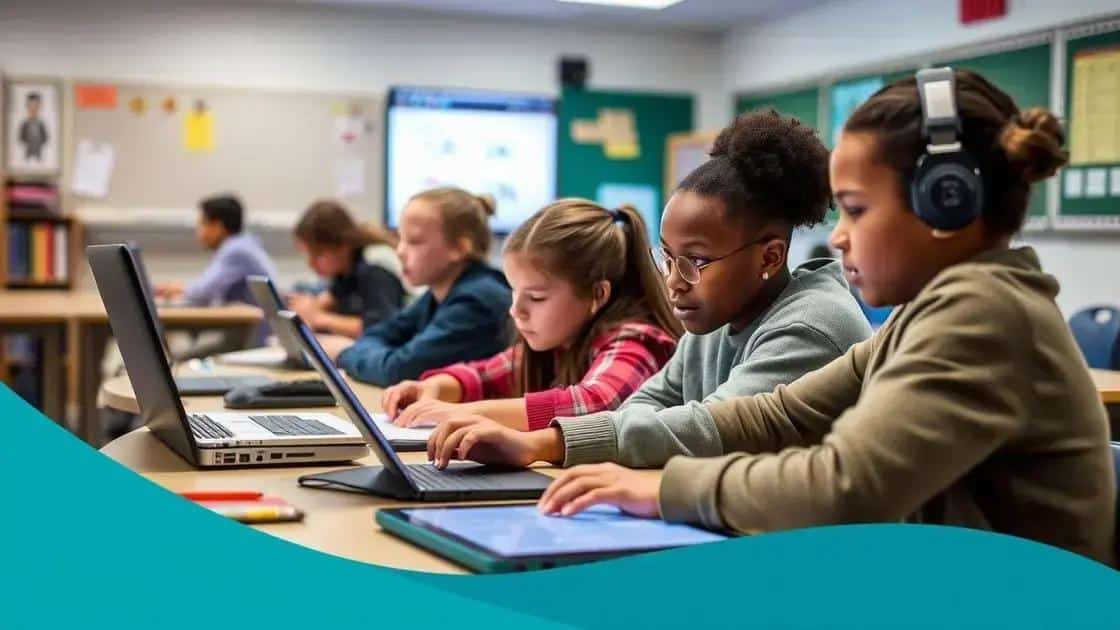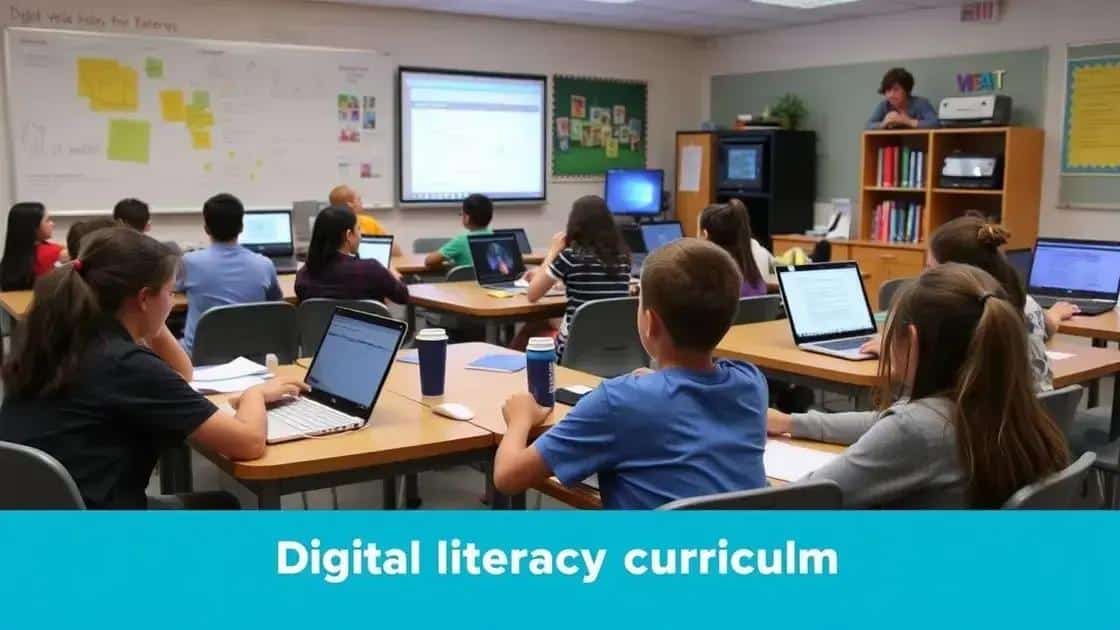Digital literacy curriculum trends that shape education

Digital literacy curriculum trends are vital for equipping students with essential skills needed for success in a technology-driven world, enhancing their job prospects and fostering informed, adaptable citizens.
Digital literacy curriculum trends are essential for equipping students with the skills they need in a technology-driven world. Have you ever wondered how these trends influence the educational landscape today? Let’s dive into this vital topic.
The importance of digital literacy in today’s world
In today’s fast-paced world, digital literacy is fundamental for success. It empowers individuals to navigate technology and critical information effectively. Without this skill, navigating daily tasks can become overwhelming.
Key Reasons for Importance
Understanding the significance of digital literacy cannot be overstated. It serves many purposes:
- Enhances job opportunities in various fields.
- Promotes informed decision-making.
- Encourages lifelong learning and adaptation.
- Supports active participation in society.
As technology evolves, so must our skills. Digital literacy influences how we communicate, learn, and even conduct business. Imagine applying for jobs without the ability to create a resume online or research your potential employers.
Transforming Education
Educational institutions are recognizing this need. Digital literacy education aims to equip students with essential skills. It often includes teaching:
- Basic computer skills.
- Online research tactics.
- Social media etiquette.
Students learn to not just consume information, but to analyze and create content responsibly. This transformation is vital, as it shapes tomorrow’s workforce.
Furthermore, digital literacy helps bridge the gap between access and opportunity. Communities that foster these skills tend to thrive. Unequal access to technology can lead to disparities in education and employment. Therefore, raising awareness and providing resources is crucial.
Current trends in digital literacy curriculum

Current trends in digital literacy curriculum reflect the changing needs of our society. Schools are adopting new methods to teach students essential skills for a digital world. By incorporating technology into classrooms, educators aim to prepare students for future challenges.
Integrating Technology in Learning
One significant trend is the integration of technology in learning environments. Teachers are using tools like:
- Interactive learning platforms.
- Online collaboration tools.
- Digital assessment methods.
This approach not only engages students but also allows them to develop hands-on experience with technology.
Another trend gaining momentum is the emphasis on critical thinking and information evaluation. As students encounter vast amounts of data online, learning to assess credibility becomes essential. They must discern reliable sources from misinformation. This skill is vital in today’s information-rich environment.
Personalized Learning Experiences
Beyond these approaches, personalized learning experiences are becoming more prevalent. With the help of data analytics, educators can tailor lessons to meet individual student needs. This customization fosters deeper understanding and mastery of digital skills.
Furthermore, interdisciplinary learning is on the rise. Students are not only learning the mechanics of technology but also its application in various subjects. For instance, integrating coding with art or science encourages creativity and innovation. This connection enhances student engagement and reinforces the relevance of digital literacy.
Overall, these trends showcase a shift towards equipping students with vital skills, emphasizing adaptability, creativity, and critical analysis in a digital age.
How schools are adapting to these trends
Schools are making significant changes to keep up with the latest digital literacy curriculum trends. As technology continues to evolve, educators understand the importance of adapting their teaching methods. This ensures that students gain essential skills for success in a digital world.
Implementing New Technologies
One way schools are adapting is by implementing new technologies in the classroom. Classrooms are being equipped with:
- Smartboards and interactive displays.
- Tablets and laptops for every student.
- Virtual learning environments.
These tools not only enhance learning but also make lessons more engaging. Students can participate actively and explore content in creative ways.
Another important adaptation is the emphasis on teacher training. Educators need to be comfortable with technology to effectively teach students. Many schools offer professional development programs that focus on:
- Using educational software.
- Integrating digital resources into lesson plans.
- Staying updated on digital literacy trends.
This training helps teachers feel confident in guiding students through complex digital landscapes.
Collaborative Learning Environments
Additionally, schools are promoting collaborative learning environments. By encouraging teamwork, students learn to solve problems together and share knowledge. This approach mirrors how many workplaces function today, preparing students for future careers.
Moreover, schools are focusing on creating flexible learning spaces. They are redesigning classrooms to encourage collaboration and interaction. These changes help facilitate group work and project-based learning, which are essential components of a robust digital literacy curriculum.
Schools also involve parents and the community in these adaptations. Workshops and seminars are organized to help families understand the importance of digital skills. Community involvement fosters a supportive atmosphere for students as they develop their digital competencies.
Future implications of digital literacy education

The future implications of digital literacy education are vast and significant. As technology continues to advance, the need for digital skills will only grow. Schools that prioritize digital literacy will prepare students for a world where technology is central to every aspect of life.
Preparing Students for the Workforce
One crucial implication is the preparation of students for the workforce. Employers increasingly seek candidates who are proficient in digital tools. Students must learn skills such as:
- Data analysis and interpretation.
- Digital communication.
- Cybersecurity awareness.
These skills help them thrive in competitive job markets. Additionally, businesses are evolving to include more technology-driven roles, making digital literacy essential for success.
Moreover, digital literacy education promotes lifelong learning. As technology changes, so must our skills. Students who are taught to adapt to new tools will be better equipped for future challenges. This adaptability is vital in a constantly shifting digital landscape.
Impact on Society
The influence of digital literacy on society is also profound. An increase in digitally literate individuals fosters innovation and creativity. When people have the skills to navigate technology, they can contribute to advancements in various fields.
Furthermore, digital literacy supports informed citizenship. As individuals can access and evaluate information critically, they are more likely to engage in community issues and participate in democratic processes. This engagement leads to a more informed and active society.
Additionally, by understanding digital tools, students can help bridge the digital divide. When more people are educated about technology, there is potential for greater equity in opportunities. This progression helps ensure that all individuals can participate in the digital economy.
In conclusion, the importance of digital literacy education cannot be understated. As technology evolves, so does the need for individuals to possess the skills necessary to navigate this digital world. Schools are taking significant steps to adapt their curricula, ensuring that students are well-prepared for the future. With increased emphasis on technology and critical thinking, students will not only enhance their job prospects but also become informed citizens who can contribute positively to society. Overall, investing in digital literacy education is essential for empowering the next generation.
\n\n\n
| Key Points 🌟 | Details |
|---|---|
| Empowerment 💪 | Digital literacy equips students with essential skills for the modern workforce. |
| Adaptability 🔄 | Students learn to adapt to new technologies, ensuring lifelong learning. |
| Critical Thinking 🧠 | Education fosters the ability to evaluate information critically. |
| Community Engagement 🤝 | Skilled individuals contribute positively to their communities. |
| Future Ready 🚀 | Preparation for future challenges in a technology-driven landscape. |
\n
\n
FAQ – Frequently Asked Questions about Digital Literacy Education
Why is digital literacy education important?
Digital literacy education is crucial as it equips students with essential skills needed for today’s technology-driven world, enhancing job prospects.
How are schools adapting to new digital literacy trends?
Schools are integrating technology into classrooms, providing teacher training, and creating collaborative learning environments to enhance digital skills.
What skills are emphasized in a digital literacy curriculum?
Key skills include critical thinking, digital communication, information evaluation, and adaptability to new technologies.
How does digital literacy impact society?
Digital literacy fosters innovation, informed citizenship, and helps bridge the digital divide, ensuring equitable opportunities for all individuals.





